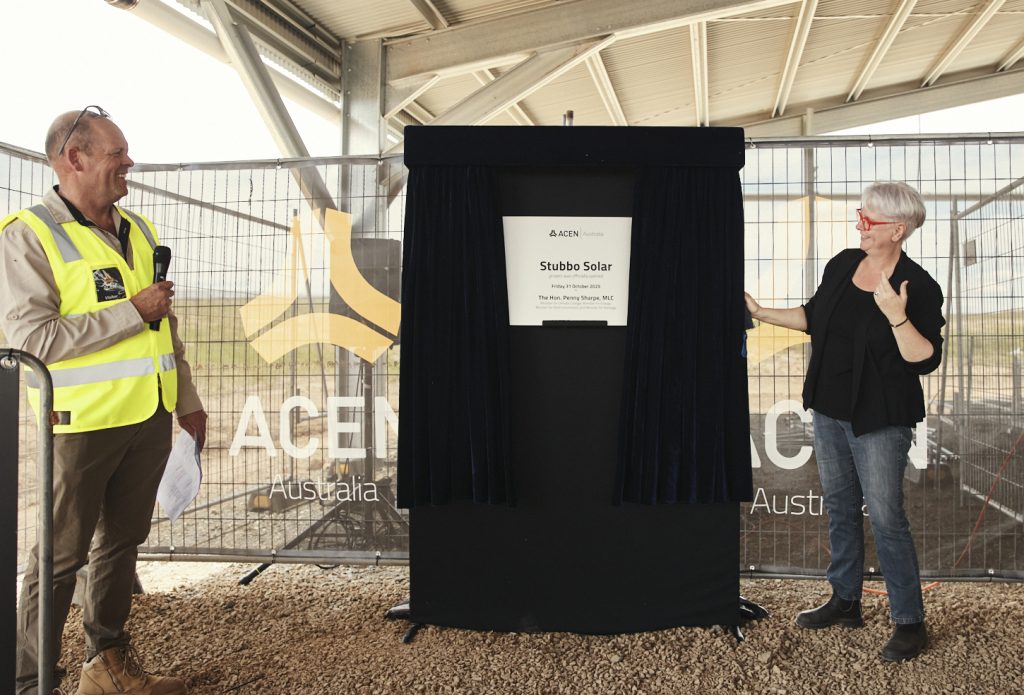ACEN Australia’s Stubbo Solar project has become the first solar generator backed by a Long-Term Energy Service Agreement (LTESA) to reach full commercial operation, marking a turning point in the state’s clean-energy transition.
Developed before the formal establishment of the Central-West Orana Renewable Energy Zone, Stubbo bridged two policy eras and is now among the largest solar projects ever built in Australia.
ACEN Australia marked the major milestone for the A$760 million, 400MW project with an official ceremony onsite on Friday, attended by New South Wales Minister for Climate Change, Energy, the Environment and Heritage Penny Sharpe.
Last week, Stubbo also became the first large-scale solar project certified for full circularity under the Circular PV Alliance framework, which will see all 930,000 of the project’s panels reused or recycled at end of life.
Stubbo Solar is located about 10km north of Gulgong in central-west New South Wales, and has the capacity to produce enough clean energy to power 185,000 Australian households.
During construction ACEN Australia invested nearly $85 million across the NSW economy, including almost $60 million in jobs, supply and contracts awarded to locals and businesses within the Mid-Western Regional Council area that hosts the project and the local council areas immediately adjacent.
The project also invested A$3.2 million with First Nations businesses, and more than A$400,000 in community development initiatives through its voluntary social investment program.
ACEN Australia Managing Director David Pollington said Stubbo’s story began several years ago, long before the policy frameworks now shaping Australia’s renewable energy landscape were in place.
“What started as a single site concept has become one of the most significant renewable energy investments in regional New South Wales, built through partnership, persistence, and strategic adaptation,” Mr Pollington said.
“As the market evolves, costs are rising, delivery conditions are changing rapidly and market dynamics are shifting – these pressures are real, and they reinforce the importance of partnership between government and industry to ensure policy settings remain responsive, effective and investment-ready.
“We’re proud to be part of this transition and look forward to working closely with the New South Wales Government, our partners and stakeholders, to deliver the next wave of clean, reliable, and affordable energy for the state.”
Stubbo’s successful delivery was made possible through strong partnerships across the project ecosystem.
PCL Construction served as ACEN Australia’s engineering, procurement and construction (EPC) contractor, while Lumea, the commercial arm of Transgrid specialising in renewable energy grid connections and infrastructure services, partnered with ACEN Australia to deliver a safe and efficient connection to the New South Wales electricity network.
PCL Construction Country Manager Gopi Govindraj said delivering Stubbo Solar was an important milestone for the company’s Australian team.
“We’re proud to have partnered with ACEN Australia to bring this landmark project to life,” Mr Govindraj said. “Stubbo Solar contributes meaningfully to Australia’s net-zero targets and the broader community, and demonstrates what can be achieved through strong collaboration and shared commitment — safely delivering large-scale renewable infrastructure that supports local jobs, regional economies, and a brighter, greener future.”
Lumea Executive General Manager Craig Stallan said early and coordinated grid planning was key to connecting the project to the grid safely and efficiently.
“We’re delighted to have connected ACEN’s game changing vision to the exciting reality of the clean energy transition here in New South Wales,” Mr Stallan said.
“We commend ACEN for their drive for innovative, more flexible grid connections that will help us all accelerate Australia’s clean energy future”.
Stubbo Solar also includes provision for a future 200MW / 800MWh battery energy storage system, positioning the site to provide firming capacity as the grid decarbonises.
ENDS

